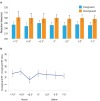Gaze Cuing Effects in Peripheral Vision
- PMID: 31019478
- PMCID: PMC6459136
- DOI: 10.3389/fpsyg.2019.00708
Gaze Cuing Effects in Peripheral Vision
Abstract
When we see another person's gaze, spatial attention shifts toward the gaze direction. Thus, a gaze perceiver can more quickly respond to a forthcoming target when it appears in a direction of a gaze giver than when it does not. This phenomenon is termed the gaze cuing effect. Previous studies have investigated the gaze cuing effect only in foveal vision; hence, it remains unclear whether the gaze cuing effect is induced when a face is presented in peripheral vision. This is an important issue because in our daily lives we communicate not only with people in front of us but also with those in our periphery. To tackle this question, we manipulated vertically aligned locations of a facial stimulus (i.e., a face stimulus appeared above or below the center fixation) and tested the extent to which a gaze cuing effect, conveyed by gaze shifts of another, is observed in the periphery. The facial stimulus was located 0, ±2.5, ±5.0, and ±7.5° of the visual angle from the center of the display, and a target was presented 5.6° to the left or right of the center of the display. In Experiment 1, when participants responded to the location of an abrupt onset of a target (i.e., localization task), we observed significant gaze cuing effects when a facial stimulus was located 0, ±2.5, and ±5.0°, but not ±7.5°. In Experiment 2, we replicated the findings in Experiment 1 if participants pressed a key only when a target appeared (i.e., detection task). In Experiment 3, we used adjusted sizes of facial images based on the cortical representations and manipulated eye directions of the facial images oriented toward the possible target locations; it resulted in enlarged effective field of view for gaze cuing effects. The study reveals that gaze cuing effects can appear even in peripheral vision and within a vertical distance of 5.0° of the visual angles, but the effective field of view is expanded when the facial image is adjusted based on the cortical representations, and eye gaze directly looks at the possible target locations.
Keywords: attention; gaze cuing effect; gaze perception; peripheral vision; visual angle.
Figures






Similar articles
-
Joint attention is intact even when visuospatial working memory is occupied.Vision Res. 2019 Jan;154:54-59. doi: 10.1016/j.visres.2018.10.011. Epub 2018 Nov 16. Vision Res. 2019. PMID: 30414850
-
Spontaneous eye-movements in neutral and emotional gaze-cuing: An eye-tracking investigation.Heliyon. 2019 Apr 30;5(4):e01583. doi: 10.1016/j.heliyon.2019.e01583. eCollection 2019 Apr. Heliyon. 2019. PMID: 31183437 Free PMC article.
-
Perceived gaze direction in faces and spatial attention: a study in patients with parietal damage and unilateral neglect.Neuropsychologia. 2002;40(7):1013-26. doi: 10.1016/s0028-3932(01)00153-1. Neuropsychologia. 2002. PMID: 11900753
-
Does facial expression affect attention orienting by gaze direction cues?J Exp Psychol Hum Percept Perform. 2003 Dec;29(6):1228-43. doi: 10.1037/0096-1523.29.6.1228. J Exp Psychol Hum Percept Perform. 2003. PMID: 14640840
-
Facial cues of dominance modulate the short-term gaze-cuing effect in human observers.Proc Biol Sci. 2010 Feb 22;277(1681):617-24. doi: 10.1098/rspb.2009.1575. Epub 2009 Oct 28. Proc Biol Sci. 2010. PMID: 19864283 Free PMC article.
Cited by
-
How eccentricity modulates attention capture by direct face/gaze and sudden onset motion.Atten Percept Psychophys. 2025 Feb;87(2):354-366. doi: 10.3758/s13414-025-03015-8. Epub 2025 Feb 6. Atten Percept Psychophys. 2025. PMID: 39915431 Free PMC article. Clinical Trial.
-
The N170 event-related potential differentiates congruent and incongruent gaze responses in gaze leading.Soc Cogn Affect Neurosci. 2020 Jun 23;15(4):479-486. doi: 10.1093/scan/nsaa054. Soc Cogn Affect Neurosci. 2020. PMID: 32364608 Free PMC article.
-
How does gaze to faces support face-to-face interaction? A review and perspective.Psychon Bull Rev. 2020 Oct;27(5):856-881. doi: 10.3758/s13423-020-01715-w. Psychon Bull Rev. 2020. PMID: 32367351 Free PMC article. Review.
-
Gaze-cued shifts of attention and microsaccades are sustained for whole bodies but are transient for body parts.Psychon Bull Rev. 2022 Oct;29(5):1854-1878. doi: 10.3758/s13423-022-02087-z. Epub 2022 Apr 5. Psychon Bull Rev. 2022. PMID: 35381913 Free PMC article.
-
How face-like objects and averted gaze faces orient our attention: The role of global configuration and local features.Iperception. 2025 Jul 23;16(4):20416695251352129. doi: 10.1177/20416695251352129. eCollection 2025 Jul-Aug. Iperception. 2025. PMID: 40823258 Free PMC article.
References
-
- Baron-Cohen S. (1995). Mindblindness: An essay on autism and theory of mind. (Cambridge, MA: MIT Press; ).
LinkOut - more resources
Full Text Sources
Other Literature Sources

